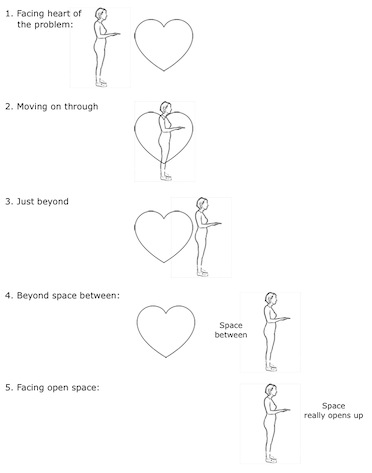This is the final part of my general feedback to advanced facilitators. The others are:
- Questions I frequently ask of the facilitators.
- Things facilitators tend to do too early – and what to do instead
- How not to make decisions for the client.
- How to track where the client is perceiving from.
4. How to track where the client is perceiving from
An important question-to-self when modelling symbolically is: Where is the client perceiving from?. Since the perspective available to a perceiver can shift every time the perceiver moves, it is doubly important to be able to track those changes. This is a sophisticated skill that takes some getting used to. It is worth learning because some clients’ landscapes will make little sense unless you can follow the changing locus of each perceiver’s attention.
Imagine a client says:
The black heart of the problem is in front of me about an arms length away. I’d like to move through the black heart and move beyond it so there is space between me and it. Then the space really opens up.
Using our Problem-Remedy-Outcome (PRO) model we can categorise each of the client’s statements:
1. The black heart of the problem is in front of me about an arms length away. [Problem]
2. I’d like to move through the black heart [Remedy]
3. and move beyond it [Remedy]
4. so there is space between me and it. [Remedy]
5. Then the space really opens up. [desired Outcome]
The first four statements all indicate the perceiver has his/her attention on the problem, “black heart” – albeit to a lesser and lesser degree. My modelling of where the client is perceiving their landscape from, schematically looks like the following (time increases from 1 to 5):

There are three named ‘spaces’ :
1. The space (in front) that is an arm’s length away
4. The space (behind) that is between
5. The space (in front) that opens up
(There is possibly a space ‘inside’ heart in #2, and another ‘little space’ between heart and Perceiver in #3, but we don’t know for sure.)
The client’s attention may be able to move around this landscape at lightening like speed and when they speak about a ‘space’ they will know exactly which one they mean. As the facilitator you will need to have your wits about you to keep track. As you learn to do this, the client will feel like you are accompanying them around his or her landscape and you will have a deep rapport with both.
The next step is to ponder two questions that are effectively equivalent:
Where in the landscape, and when in the sequence, would be most useful for the client to attend to?
If we consider all the options, and not just go for the desired outcome, we can invite the client to attend to any one of the five space-time frames listed above. [There are at least two others — before #1 and after #5 — but we’ll ignore these for the time being.]
Whichever we decide, we need to choose our words carefully. We will need to set the appropriate frame by using the context-defining 2nd part of the Clean Language syntax, ‘And when/as …’, before we ask the question. Thus:
1. And when black heart of the problem is in front of you about an arms length away ……
2. And as you move through black heart ……
3. And as you move beyond black heart ……
4. And when there is space between you and black heart ……
5. And as that space really opens up ……
And then we can consider:
Within that where and when frame, what would it be most useful for the client to attend to? e.g.
1. …… is there anything else about that arms length?
2. …… what kind of move through is that?
3. …… where is that beyond?
4. …… how much space is there between you and black heart?
5. …… what kind of space is that space that really opens up?
The five questions are just examples, others could be asked. Chances are that as long as the question maintains the same time-space frame (i.e. it is a developing question), it will not matter much which question you ask since the client’s attention will be in the appropriate time and space to access the information they need.
By modelling where the client perceives from, and the time and space characteristics of their landscape we not only acknowledge the client’s inner realty from their perspective, we are able to invite them to attend to salient aspects with much greater precision. The result? The client will access places and discover things that they never knew they knew.
– 0 – 0 – 0 – 0 – 0 –
If you would like to know more about how to model metaphors see Penny Tompkins and my articles:








